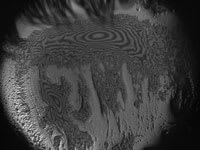discovering
dry eye
A
Look Back at the Year in Lens-related Dry Eye
BY
KELLY K. NICHOLS, OD, MPH, PHD
I'm reminded at this time of year to reflect on the good things and to plan for the future. In looking back over the last 12 months, a best-of list of pearls in lens-related dry eye comes to mind.
Meibomian gland disease is common in contact lens wearers and can lead to lens discomfort. Treat aggressively with warm compresses, lid hygiene and/or doxycycline.
Patient management in contact lens-related dry eye takes time, but the rewards are worth it. Book the extra time-slot, perform a dry eye work-up (bill medically for it) and your patients will appreciate the extra attention to the problem.
Add lissamine green to your contact lens dry eye diagnosis protocol. Significant conjunctival staining in a ring pattern and superior lid margin staining (lid wiper epitheliopathy) may be correlated with symptomatic contact lens wear.
|
|
|
Figure 1. Interferometric analysis of tear film thinning over a silicone hydrogel lens surface |
Dry eye has an inflammatory component. Whether the etiology of the condition is inflammatory or inflammation is a result of the disease process, bulbar conjunctival and/or lid margin injection can be subtle signs that you can monitor with treatment.
Changes in a patient's quality lens wear (and quality of life) can be very meaningful. Ask about and monitor the number of times a patient uses lubricant eye drops and the difference between total lens wear time and comfortable lens wear time. Improvements in either by a minimal amount may have a significant impact on satisfaction with contact lens wear.
Best photo: Can a picture speak 1,000 words? (Figure 1).
We have a lot to learn about the interaction among the lens surface, tear film thinning, evaporation and symptoms. The future will hold specific solution/ lens pairings to maximize tear film stabilization and comfort.
A step-wise approach catered to each patient is the most successful in managing contact lens-related dry eye. Consider contact lens characteristics, wearing schedule, lens solutions, lubrication, lid disease management, cyclosporine, nutraceuticals, punctal occlusion and reduced contact lens wear time.
Symptomatic contact lens wearers have "sticky" tears. Have your new dry eye patients commit to a two-week trial of lubricant eye drops three to four times a day (pre-lens wear, during and post lens wear). It takes two weeks to make a new habit (and the New Year is a great time to start one!).
You can successfully use cyclosporine (Restasis, Allergan) with contact lens patients. Discuss medical management with your patients, including the financial cost/benefit ratio of reducing artificial tear use.
Don't change everything at once. Write down what you recommend, then follow up.
Watch for guidelines. Recommendations on treatment from the international task force Delphi panel and the status of the dry eye field (research, etiology, diagnosis and management and clinical trials) from the international Dry Eye Workshop (DEWS) will be published in 2007.
The New Year promises to bring more advances in disease management, new products and treatments. Stay tuned!
Dr. Nichols is an associate professor at The Ohio State University College of Optometry in the area of dry eye research.




